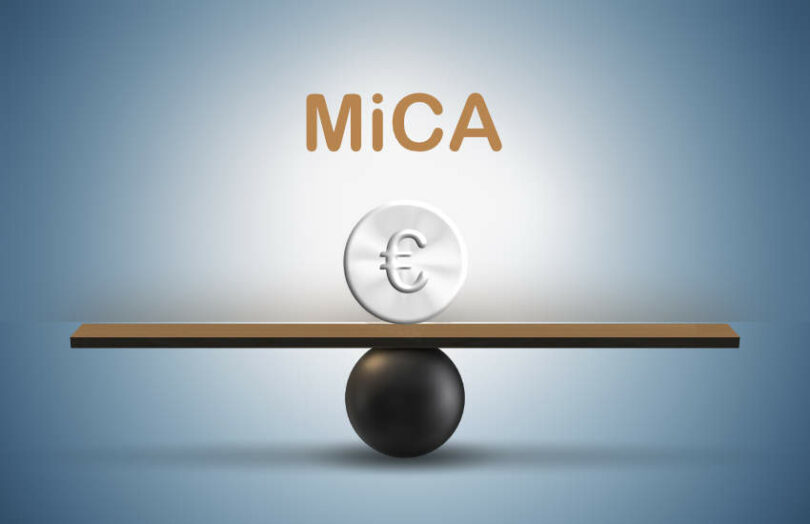Highlights
- MiCA bans interest/benefit payments for stablecoins
- This likely applies only to interest paid by the issuer
- DeFi protocols often provide regulated activities
- National regulators could decide someone controls the DeFi protocol (is a CASP)
- Every transaction other than P2P self custody is caught by AML travel rule (no €1,000 minimum)
- Do stablecoin issuers have to KYC every holder?
With the EU’s Markets in Crypto Assets Regulations (MiCAR) receiving a final vote tomorrow, some have wondered about the impact on stablecoins. Specifically, if a ban on stablecoin interest could inhibit decentralized finance (DeFi) and how additional anti-money laundering (AML) crypto-asset regulations could impact transactions. Stablecoins should do just fine despite the interest ban and vastly expanded AML, but the conclusion comes with caveats.
There was no intention for the first iteration of MiCAR to address DeFi explicitly. However, as we’ll show, it would be a mistake to assume that all DeFi protocols get a free pass.
MiCA bans stablecoin interest and benefits
Starting with the MiCAR interest clause, stablecoins are either e-money tokens or asset-referenced tokens, but there’s a ban on interest on both.
The big picture vision for stablecoins is to create a low cost programmable form of payments for everyday use. Today adoption for these purposes is limited, and DeFi has been one of the growth engines of stablecoins. A big part of that has been the use of stablecoins on DeFi lending and borrowing protocols such as Compound and Aave. And they pay interest.
Article 45 Prohibition of interests
By derogation to Article 12 of Directive 2009/110/EC, no issuer of e-money tokens or crypto-asset service providers shall grant interest or any other benefit related to the length of time during which a holder of e-money tokens holds such e-money tokens.
So the question is whether these interest clauses mean that regulators will pursue Aave and Compound for paying interest. The answer boils down to two factors: is the protocol interest the same type of interest or benefit that the prohibition refers to? And do Aave and Compound get a free pass because this iteration of MiCAR doesn’t directly target DeFi? The answers are broadly positive for stablecoins but not clear cut.
Does the MiCA interest ban apply to lending protocols?
The interest ban clause derives from e-money laws which also ban interest to differentiate e-money from banking. Hence the real intent of the ban is to prevent the stablecoin issuer from behaving like a bank.
Clifford Chance’s Diego Ballon Ossio highlighted to Ledger Insights that the clause is positioned in the section regarding stablecoin issuance, reinforcing the view that it’s targeting stablecoin issuers. However, it also mentions crypto asset service providers (CASPs). The lawyer noted that the mention of CASPs prevents a service provider from becoming a deposit taker of electronic money.
Ledger Insights believes that the centralized crypto lender Nexo does something similar. Currently, someone can send euros to Nexo, which converts it into its own euro stablecoin EURx on which it pays interest. You won’t find EURx on crypto trading platforms because it’s an internal stablecoin which is currently allowed as an exception under current e-money regulations. But probably not with this new MiCAR clause.
Regarding whether MiCA impacts lending protocols, the Clifford Chance view is that lending protocols enable secondary value added services that are not inherently part of the stablecoin. In contrast, the interest and benefits clause intends to prevent stablecoin issuers from behaving like banks. There are analogies with other financial transactions, such as securities lending, where the compensation would not be considered a relevant interest or benefit because the issuer does not provide the service.
“If you have secondary transactions, repos (repurchase agreements), securities lending or collateral and I make my assets available, that is not inherent to the asset as such, that is an extra service,” said Clifford Chance partner Marc Benzler. But he added that it depends on the specific circumstances.
There was also the question of whether a return earned on money deposited in a liquidity pool for automated market makers (AMM) would be a benefit tied to the stablecoin. However, that would even more obviously be a secondary type of transaction. But there could be unexpected legal risks involved in liquidity pool participation, as we’ll explore later.
Do DeFi protocols get a free pass?
Despite MiCAR not explicitly targeting DeFi, some DeFi protocols could be targeted for enforcement by national regulators.
“DeFi is the elephant in the room with MiCA,” said Ballon Ossio. “It’s been kicked down the road. And it creates circumstances where the rules either don’t work or can be circumvented by using the technology. The person who’s doing that carries a degree of legal risk.”
While MiCA is a uniform regulation across the EU, it will be enforced by national regulators, which means the treatment won’t be the same everywhere.
MiCAR particularly targets the activities of crypto asset service providers (CASPs), meaning centralized finance (CeFi) providers are the main players impacted. However, if a national regulator deems that someone involved in a DeFi protocol controls the processes and is involved in a regulated activity, they will consider them a CASP.
The draft regulation covers a list of a dozen CASP activities which include functions that DeFi protocols often perform, such as:
- operating a trading platform
- the exchange of crypto-assets for other crypto-assets
- the reception and transmission of orders for crypto-assets on behalf of third parties.
Ballon Ossio says a regulator isn’t going to target a decentralized autonomous organization (DAO) just because it’s a DAO. “They couldn’t get them because they’re a DeFi protocol. They’d have to get them because they’re doing one of the CASP activities and somebody is responsible for it, and they haven’t gotten a license for it,” he said.
A decision on whether someone is carrying on a particular activity is a question of local law and the particular facts. For example, in some jurisdictions, it could be a matter of whether someone controls the code or has significant influence even if they are not the sole controller.
“The question is can you prove it, make a case, bring an enforcement action?” he added. “You have layers of regulatory decision-making that might prevent anything happening to the protocol. But the fundamental principle of whether it is out of scope because it’s a protocol is something I think that regulators will push back on.”
Hence, DeFi protocols won’t necessarily get a free pass. But they also are less likely to be the first targets of enforcement.
Stablecoins, AML and the travel rule
A raft of new EU laws around anti money laundering are being finalized that include crypto but are not specific to it. Additionally, specific AML crypto-asset legislation for the so-called travel rule had its final debate alongside MiCAR today.
Dealing first with the travel rule, one surprise is the EU has dropped the de minimis threshold of €1,000, meaning every single transaction involving a CASP will require the AML travel rule data to be passed along.
The one plus of the travel rule is it doesn’t apply to self custody transactions that don’t involve a CASP. The draft law has a clause that excludes transactions where “the transfers constitute person-to-person transfers of crypto-assets carried out without the involvement of a crypto-asset service provider.” And it adds that e-money tokens are considered as crypto-assets for this clause.
Will AML mean every stablecoin holder must be KYC’d?
The broader AML legislation raises some thorny questions for stablecoins.
The legislation considers an e-money issuer as a financial institution with an AML responsibility when establishing a business relationship or if token holders plan “occasional” transactions.
Some argue that a holder of a stablecoin has a relationship with the issuer and hence the stablecoin issuer needs to perform AML on every holder, which would be bad news for stablecoins.
A contrasting view is to consider an analogy, such as whether a bond issuer has to perform KYC or AML relating to secondary market transactions in which it has no direct involvement. A different example is insurers only need to perform AML on beneficiaries at the point of payout. So a stablecoin issuer could execute KYC and AML at redemption.
However, this is a topic where we have yet to come to a definitive conclusion.
The many MiCA questions
After the detour on the separate AML legislation, one final point regarding MiCA is the considerable uncertainty around many aspects of the bill. But that is the norm for financial market regulations. The industry will lobby and the regulators will respond with answers to frequently asked questions.
Talking generally about financial services regulations, Ballon Ossio observed, “It’s surprising how sophisticated players are used to dealing with uncertainty in the context of financial services regulation.” He added, “If you come at it cold, there are lots of gaps in there that the market has dealt with through custom and now has become settled. That needs to happen with MiCA.”
Thanks to Manuel Klein and Nicolaes Tollenaar for inspiring the article, discussions and feedback.






